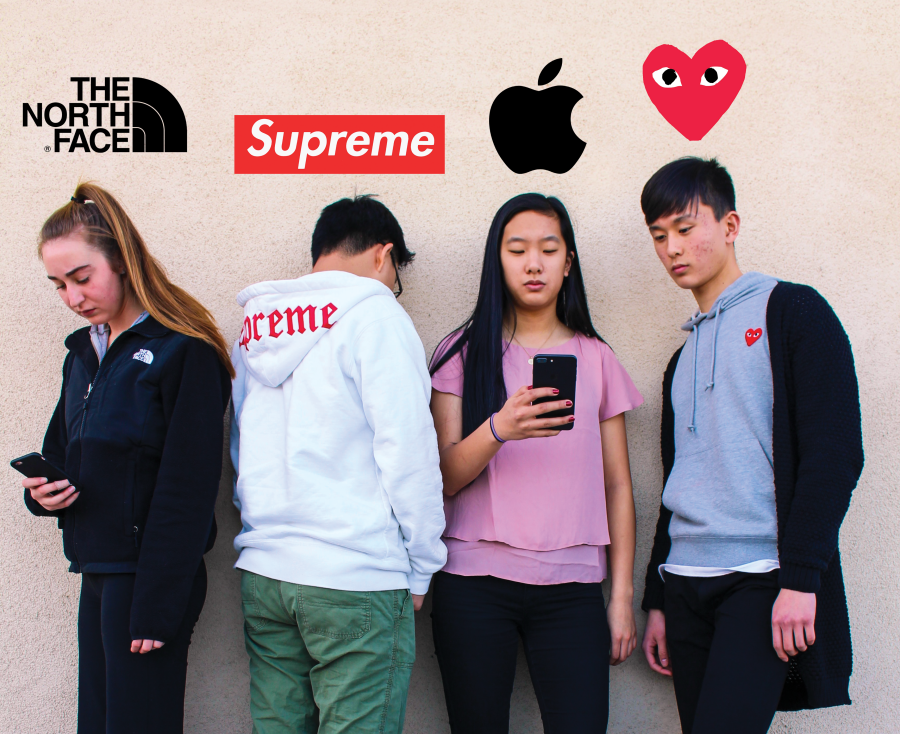You see it all the time — your peers walking from class to class, rocking the most fashionable brands, iPhones clutched tightly against North Face vests or Longchamp bags. For many students at Palo Alto High School and across the country, touting designer brands or having the latest luxury products is rapidly becoming the norm.
These brands often have a few common elements. They are expensive, well-known and in some cases, hard to come by. One such example is the New York skateboarding brand, Supreme. Every Thursday morning, Supreme drops its latest clothing online. In turn, every Thursday morning during their second period classes, a few Paly students refresh the brand’s homepage in hopes of obtaining the company’s highly sought-after merchandise.
Supreme is just one of the many exclusive brands Paly students often flaunt. Navigating through the websites of these designers proves to be such a challenge that only the most dedicated of fans are able to buy their products. One such example is designer Comme-des-Garcon. When clicking through the brand’s homepage you are greeted with a series of artsy photographs, with no actual products in sight.
Students wear brands for different reasons. Paly junior Brian Xu explains his peers’ motivations for wearing brands.
“We wear clothes for other humans to see our clothes, and to think of our prestige and our social status,” Xu said.
These cues gleaned through observing people’s clothing can influence social interactions and define one’s circle of friends.
Another perspective on wearing brands comes from self-proclaimed fashion guru Andrew Park, a junior who says that identifying with certain clothing companies allows him to have a common interest with others. He contrasted wearing flashy brands to more modest unbranded clothes, and how people reacted to him.
“People catch on right away,” Park said. “They notice that you’re that kind of person. They like to interact with you more. They ask you questions about how you got [the clothes].”
There are those who live, breathe and judge based on fashion. And there are those who find that lifestyle groundless. On the other side of the spectrum from Park is junior Rachel Hu, who is not impressed by people wearing flashy brands.
“When I see someone wearing a brand like Supreme or something I think they spend a lot of time trying to impress people and spend too much money,” Hu said.
For Hu, brands represent people who have different values from her. The presence of brands influences who she interacts with.
Groups that form at lunchtime provide clear examples of the role of brands in social interactions. Brand aggregation is prominent largely amongst the most fashion-conscious people. Students with A Bathing Ape camo hoodies, Supreme shirts and squeaky-clean Adidas NMD sneakers often gather together in clusters across the green lawn of the quad like globules of unified fashion enthusiasts.
Junior Amanda Hmelar recognizes this pattern, even amongst seventh graders like her sister and her sister’s friends.
“My sister is in seventh grade and she’s much trendier than me,” Hmelar said. “She wears more Hypebeast brand names than me and her friends are all into all of that.”
“Hypebeasts,” as Hmelar refers to them, are people who collect clothes, shoes or other merchandise from expensive brands usually with the intention of flaunting them or showing off.
But even back at Paly amidst the clusters of high-end designer wears are a few easily identifiable groups brimming with diversity in clothing. One such example of a member of these diverse groups is the fashion-savvy Park.
“For me, I have lots of friends who don’t care about fashion and it’s not that big of a deal,” Park said.
An underlying reason for this growing phenomenon could be the validation teens gain through wearing these designer labels. As Xu says, you “get some acknowledgement from some people” when wearing designer clothes. This sentiment was echoed by many of the Paly students interviewed. The validation that comes with these expensive clothes can be important, especially as insecure teenagers navigate through the challenges of high school and transitioning to adulthood.
Additionally, there has been a growing trend of Instagram-famous celebrities endorsing branded clothing. When these endorsements come from celebrities rather than companies, they feel more authentic and are able to inspire teenagers to go out and buy these brands to mimic the style of their favorite celebrities, whether it be Taylor Swift, Kanye West or Beyonce. Perhaps because of this, the taste of some Paly students may not be self-created, but rather dictated by consumerist forces interested only in the bottom line.

